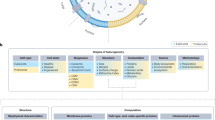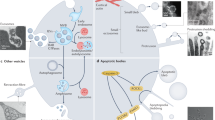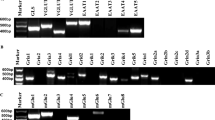Abstract
Extracellular vesicles (EVs) are membrane particles involved in the exchange of a broad range of bioactive molecules between cells and the microenvironment. Although it has been shown that cells can traffic metabolic enzymes via EVs, much remains to be elucidated with regard to their intrinsic metabolic activity. Accordingly, herein we assessed the ability of neural stem/progenitor cell (NSC)-derived EVs to consume and produce metabolites. Our metabolomics and functional analyses both revealed that EVs harbor L-asparaginase activity, catalyzed by the enzyme asparaginase-like protein 1 (Asrgl1). Critically, we show that Asrgl1 activity is selective for asparagine and is devoid of glutaminase activity. We found that mouse and human NSC EVs traffic Asrgl1. Our results demonstrate, for the first time, that NSC EVs function as independent metabolic units that are able to modify the concentrations of critical nutrients, with the potential to affect the physiology of their microenvironment.
This is a preview of subscription content, access via your institution
Access options
Access Nature and 54 other Nature Portfolio journals
Get Nature+, our best-value online-access subscription
$29.99 / 30 days
cancel any time
Subscribe to this journal
Receive 12 print issues and online access
$259.00 per year
only $21.58 per issue
Buy this article
- Purchase on Springer Link
- Instant access to full article PDF
Prices may be subject to local taxes which are calculated during checkout




Similar content being viewed by others
References
Deatherage, B.L. & Cookson, B.T. Membrane vesicle release in bacteria, eukaryotes, and archaea: a conserved yet underappreciated aspect of microbial life. Infect. Immun. 80, 1948–1957 (2012).
Raposo, G. & Stoorvogel, W. Extracellular vesicles: exosomes, microvesicles, and friends. J. Cell Biol. 200, 373–383 (2013).
Kim, D.K., Lee, J., Simpson, R.J., Lötvall, J. & Gho, Y.S. EVpedia: A community web resource for prokaryotic and eukaryotic extracellular vesicles research. Semin. Cell Dev. Biol. 40, 4–7 (2015).
Kalra, H. et al. Vesiclepedia: a compendium for extracellular vesicles with continuous community annotation. PLoS Biol. 10, e1001450 (2012).
Théry, C., Ostrowski, M. & Segura, E. Membrane vesicles as conveyors of immune responses. Nat. Rev. Immunol. 9, 581–593 (2009).
Cossetti, C. et al. Extracellular vesicles from neural stem cells transfer IFN-γ via Ifngr1 to activate Stat1 signaling in target cells. Mol. Cell 56, 193–204 (2014).
Garcia, N.A., Moncayo-Arlandi, J., Sepulveda, P. & Diez-Juan, A. Cardiomyocyte exosomes regulate glycolytic flux in endothelium by direct transfer of GLUT transporters and glycolytic enzymes. Cardiovasc. Res. 109, 397–408 (2016).
Ronquist, K.G., Ek, B., Stavreus-Evers, A., Larsson, A. & Ronquist, G. Human prostasomes express glycolytic enzymes with capacity for ATP production. Am. J. Physiol. Endocrinol. Metab. 304, E576–E582 (2013).
Minciacchi, V.R. et al. Large oncosomes contain distinct protein cargo and represent a separate functional class of tumor-derived extracellular vesicles. Oncotarget 6, 11327–11341 (2015).
Johnson, S.M. et al. Metabolic reprogramming of bone marrow stromal cells by leukemic extracellular vesicles in acute lymphoblastic leukemia. Blood 128, 453–456 (2016).
Zhao, H. et al. Tumor microenvironment derived exosomes pleiotropically modulate cancer cell metabolism. eLife 5, e10250 (2016).
Lobb, R.J. et al. Optimized exosome isolation protocol for cell culture supernatant and human plasma. J. Extracell. Vesicles 4, 27031 (2015).
Théry, C. et al. Molecular characterization of dendritic cell-derived exosomes. Selective accumulation of the heat shock protein hsc73. J. Cell Biol. 147, 599–610 (1999).
Quillin, M.L. & Matthews, B.W. Accurate calculation of the density of proteins. Acta Crystallogr. D Biol. Crystallogr. 56, 791–794 (2000).
Mazzini, L. et al. Human neural stem cell transplantation in ALS: initial results from a phase I trial. J. Transl. Med. 13, 17 (2015).
Poliakov, A., Spilman, M., Dokland, T., Amling, C.L. & Mobley, J.A. Structural heterogeneity and protein composition of exosome-like vesicles (prostasomes) in human semen. Prostate 69, 159–167 (2009).
Cantor, J.R., Stone, E.M., Chantranupong, L. & Georgiou, G. The human asparaginase-like protein 1 hASRGL1 is an Ntn hydrolase with β-aspartyl peptidase activity. Biochemistry 48, 11026–11031 (2009).
Kourembanas, S. Exosomes: vehicles of intercellular signaling, biomarkers, and vectors of cell therapy. Annu. Rev. Physiol. 77, 13–27 (2015).
Tkach, M. & Théry, C. Communication by extracellular vesicles: where we are and where we need to go. Cell 164, 1226–1232 (2016).
Xu, L., Yang, B.F. & Ai, J. MicroRNA transport: a new way in cell communication. J. Cell. Physiol. 228, 1713–1719 (2013).
Fafournoux, P., Bruhat, A. & Jousse, C. Amino acid regulation of gene expression. Biochem. J. 351, 1–12 (2000).
Braicu, C. et al. Exosomes as divine messengers: are they the Hermes of modern molecular oncology? Cell Death Differ. 22, 34–45 (2015).
Christie, G.R., Hyde, R. & Hundal, H.S. Regulation of amino acid transporters by amino acid availability. Curr. Opin. Clin. Nutr. Metab. Care 4, 425–431 (2001).
Witwer, K.W. et al. Standardization of sample collection, isolation and analysis methods in extracellular vesicle research. J. Extracell. Vesicles 2, (2013).
Birsoy, K. et al. An essential role of the mitochondrial electron transport chain in cell proliferation is to enable aspartate synthesis. Cell 162, 540–551 (2015).
Sullivan, L.B. et al. Supporting aspartate biosynthesis is an essential function of respiration in proliferating cells. Cell 162, 552–563 (2015).
Petroff, O.A. GABA and glutamate in the human brain. Neuroscientist 8, 562–573 (2002).
Watanabe, M. et al. Gamma-aminobutyric acid (GABA) and cell proliferation: focus on cancer cells. Histol. Histopathol. 21, 1135–1141 (2006).
Stepulak, A., Rola, R., Polberg, K. & Ikonomidou, C. Glutamate and its receptors in cancer. J. Neural Transm. (Vienna) 121, 933–944 (2014).
Pavlides, S. et al. The reverse Warburg effect: aerobic glycolysis in cancer associated fibroblasts and the tumor stroma. Cell Cycle 8, 3984–4001 (2009).
Sonveaux, P. et al. Targeting the lactate transporter MCT1 in endothelial cells inhibits lactate-induced HIF-1 activation and tumor angiogenesis. PLoS One 7, e33418 (2012).
Haas, R. et al. Lactate regulates metabolic and pro-inflammatory circuits in control of T cell migration and effector functions. PLoS Biol. 13, e1002202 (2015).
Bush, L.A. et al. A novel asparaginase-like protein is a sperm autoantigen in rats. Mol. Reprod. Dev. 62, 233–247 (2002).
Duval, M. et al. Comparison of Escherichia coli-asparaginase with Erwinia-asparaginase in the treatment of childhood lymphoid malignancies: results of a randomized European Organisation for Research and Treatment of Cancer-Children's Leukemia Group phase 3 trial. Blood 99, 2734–2739 (2002).
Karpel-Massler, G. et al. Metabolic reprogramming of glioblastoma cells by L-asparaginase sensitizes for apoptosis in vitro and in vivo. Oncotarget 7, 33512–33528 (2016).
Ollenschläger, G. et al. Asparaginase-induced derangements of glutamine metabolism: the pathogenetic basis for some drug-related side-effects. Eur. J. Clin. Invest. 18, 512–516 (1988).
Iraci, N., Tyzack, G.E., Cossetti, C., Alfaro-Cervello, C. & Pluchino, S. Viral manipulation of neural stem/precursor cells. Neuromethods 82, 269–288 (2013).
Acknowledgements
The authors thank F. Dazzi, C. Mauro, J. Smith and A. Tolkovsky for critically discussing the article. We are grateful to J. Muzard (iZON) for his help with the qNano. We acknowledge the technical assistance of I. Bicci, M. Davis, F. Gessler, G. Pluchino and B. Vega-Blanco. This work has received support from the Italian Multiple Sclerosis Association (AISM; grant 2010/R/31 and grant 2014/PMS/4 to S.P.); the Italian Ministry of Health (GR08-7 to S.P.); the European Research Council (ERC) under the ERC-2010-StG Grant agreement no. 260511-SEM_SEM; the Medical Research Council, the Engineering and Physical Sciences Research Council and the Biotechnology and Biological Sciences Research Council UK Regenerative Medicine Platform Hub “Acellular Approaches for Therapeutic Delivery” (MR/K026682/1 to S.P.); The Evelyn Trust (RG 69865 to S.P.); The Bascule Charitable Trust (RG 75149 to S.P.); and core support grant from the Wellcome Trust and Medical Research Council to the Wellcome Trust–MRC Cambridge Stem Cell Institute. N.I. was supported by a FEBS long-term fellowship. C.F., A.S.H., and E.G. were funded by the Medical Research Council, Core Fund SKAG006.
Author information
Authors and Affiliations
Contributions
N.I., E.G., C.F. and S.P. conceived the study and designed the experiments; N.I., T.L., C.C., L.P.-J., J.D.B. and M.G. elucidated the trafficking of Asrgl1 into NSC EVs, and performed experiments including cell culture preparations, EV purification from media, tunable sensitive pulse sensing, western blots, RT and qPCR, vector production and generation of gain-of-function and loss-of-function tools; N.I., C.B. and N.F. performed nanoparticle tracking analysis; A.S.H.C. and E.G. performed the LC–MS metabolomic analyses; A.L.V., L.G.O., C.F. and S.P. provided key reagents and resources; N.I., E.G., A.S.H.C., T.L., H.K.S., A.J.E., C.F. and S.P. analyzed the data and interpreted and discussed the results; N.I., E.G., C.F. and S.P. prepared the figures and wrote and edited the manuscript; C.F. and S.P. supervised the research.
Corresponding authors
Ethics declarations
Competing interests
N.I., E.G., T.L., C.F. and S.P. are listed as inventors on a patent application related to the technology described in this work (European Patent application no. 16189525.5).
Supplementary information
Supplementary Text and Figures
Supplementary Results, Supplementary Table 1 and Supplementary Figures 1–12 (PDF 2598 kb)
Rights and permissions
About this article
Cite this article
Iraci, N., Gaude, E., Leonardi, T. et al. Extracellular vesicles are independent metabolic units with asparaginase activity. Nat Chem Biol 13, 951–955 (2017). https://doi.org/10.1038/nchembio.2422
Received:
Accepted:
Published:
Issue Date:
DOI: https://doi.org/10.1038/nchembio.2422
This article is cited by
-
Metabolomic profiling of exosomes reveals age-related changes in ovarian follicular fluid
European Journal of Medical Research (2024)
-
Metabolomic investigation of urinary extracellular vesicles for early detection and screening of lung cancer
Journal of Nanobiotechnology (2023)
-
Neural stem cell-derived exosomes and regeneration: cell-free therapeutic strategies for traumatic brain injury
Stem Cell Research & Therapy (2023)
-
Mechanisms of axonal support by oligodendrocyte-derived extracellular vesicles
Nature Reviews Neuroscience (2023)
-
Extracellular vesicles from neural progenitor cells promote functional recovery after stroke in mice with pharmacological inhibition of neurogenesis
Cell Death Discovery (2023)



